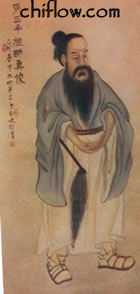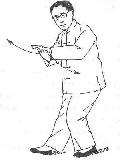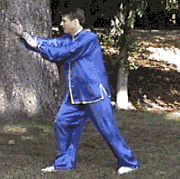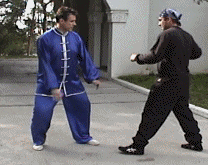|
1. Taichichuan Ching (classic) attributed to Cheng San-Feng
Taichichuan is based on a Taoist philosophical approach with an open implementation. Taichichuan comes out of Wuji, an undifferentiated whole, which bifurcates into differentiated parts: this is the mother of yin and yang (the insubstantial and the substantial; movement and stillness).
- In movement Taichichuan differentiates. In stillness Taichichuan integrates. (Taichichuan involves the process of finding movement in stillness and finding stillness in movement.)
- Taichichuan must be neither overdone or underdone. (Do not go past or fall behind. The approach of Taichichuan is to stay connected, so both excess and deficiency are wrong.)
- Follow, fold your opponent - counterpart then extend.
- The approach of Tai Chi is to meet hardness with softness. (If my opponent/counterpart uses hard gang jin , I use soft rou jin. Engage and yield to aggression, but follow and do not "run away.") This is to "go along with."
- The opponent/counterpart goes against me in confrontation, but I yield and go with him. When you are in a favorable situation and your opponent is in an unfavorable situation, you adhere to your opponent. This is "sticking to." (Advance or retreat, but do not "run away" from aggression. Separation is an error.)
- Have a rapid response for rapid attacks and a slow response for slow attacks. (The key is to stay with the actions of the opponent - counterpart. Going too fast to be able to stay connected and going to slow to be able to stay connected are both wrong.)
- Although the changes and variations have many strands, the basic principles form one thread. Again, Taichichuan is based on a Taoist philosophical approach with an open implementation.
|
2. Taichichuan Ching (classic) attributed to Cheng San-Feng
Your skill in the mastery of jin (force, strength, energy, power, spirit) will be gradually obtained through experiencing the touch and practicing the zhe (taking the measure of the situation, understanding intention). From mastery of jin, you may advance step by step to a spiritually enlightened state. But unless you pursue the art long enough, you cannot gain understanding and mastery.
- Lift/empty the head and straighten the lively neck. Sink the chi to the lower abdomen (dan tian). ("Empty" is the opposite of obstructed and stagnant. There is also a possible Taoist reference here to an unclouded mind that approaches things as they are with no preconception.)
- There should be no distortion or deviation, that is -- maintain your equilibrium.
- Your jin (force, strength, energy, power, spirit) seems to suddenly disappear, and suddenly appear.
- If the left is made substantial, then the left is ready to become insubstantial. If the right is made substantial, then the right is ready to become insubstantial.
- When your jin (force, strength, energy, power, spirit) is directed upward, it goes even higher up. When your jin is directed downward, it goes even deeper down.
- Your jin (force, strength, energy, power, spirit) is longer than the opponent/counterpart when you advance and crowds closer to your opponent/counterpart when you retreat.
- When in balance, a feather cannot be added not a fly land.
- Your jin (force, strength, energy, power, spirit) and intentions are not to be detected, while your opponent's / counterpart's intentions are easily read. This is the reason the master is unmatched.
|
|
3.Taichichuan Ching (classic) attributed to Cheng San-Feng (continued)
There are many counterintuitive aspects of Taichichuan. Although the approach of Taichichuan is varied, it is unique in martial arts because it never relies on strength to beat the weaker person and never uses swiftness to subdue the slower one. The reliance on strength and speed are mainly inherited instincts that are not related to the learned skills that Taichichuan teaches.
- An axiom of Taichichuan is that four ounces can be used to defect a thousand pounds. This is the way that an old man can fight (drive or ward off) a crowd. It cannot be the result of applying overwhelming strength. It cannot be the result of using more speed.
- When standing, to perform Taichichuan is like being poised on a balance scale.
- When moving, to perform Taichichuan is to be as agile as a running cart wheel.
- Tipping to one side leads to falling.
- Double weighting is associated with stopping / stagnation.
|
4. Taichichuan Ching (classic) attributed to Cheng San-Feng (continued)
continued:
- Those who fail to master the skill of Taichichuan are often subdued by others because they commit the error of double weighting. To avoid this, one must know yin and yang (and differentiate the substantial and the insubstantial / integrate movement and stillness. Double weighting is also associated with the failure to differentiate the substantial and the insubstantial / integrate movement and stillness.)
- "Sticking to" comprises "go along with" and "go along with" comprises "sticking to." Yin does not leave yang, and yang does not leave yin. (That is, the substantial and the insubstantial should be differentiated, but there should not be distance between them.)
- Mastery of jin (force, strength, energy, power, spirit) is based on the mutual complement of yin and yang. If mastery of jin is attained, the more you practice, the more your skill will increase: and the more you study and contemplate, the more you will expand your understanding of what is possible and what you can achieve.
- Instead of engaging and following your opponent's initiative / aggression without imposing your own initiative / aggression, one is often mistaken by failing to see what is close at hand and easy in search of something far and difficult. (The approach of Taichichuan is to accept things for the way they are, yield, neutralize, follow, wait for the opportunity and then exploit it. The "search for something far and difficult" is usually driven by an idea or an attempt to impose your own initiative instead of accepting things for the way they are. This approach violates Taichichuan principles and almost always ignores many opportunities that are close at hand and easy to exploit.) By making a small mistake, you may go wrong by a thousand miles. Beginners should bear this in mind.
|
|
5. Serial Form - Eight methods
Long-Chuan, which denotes the serial forms, is like the flow of water in a great river or sea, running without end. The thirteen kinetic movements are:
- pung (warding),
- lu (diverting),
- ji (pressing),
- an (pushing),
- tsai (plucking),
- li (twisting),
- zhou (elbowing),
- and koa (leaning)
which are connected with eight trigrams,
|
6. Serial Form - Five Elements
and
- jin (stepping forward),
- tui (stepping backward),
- ku (looking to the left),
- pan (looking to the right)
- and zhong-ding (central equilibrium)
which coincide with the five elements, namely metal, wood, water, fire and earth. Pung, lu, ji and an are called the four straight direction manipulations which are associated with south, west, east and north respectively. Tsai, li, zhou, and koa are the four diagonal manipulations toward the northwest, southeast, northeast and southwest respectively.
Original annotation: this is the work of Cheng San-feng from Mt. Wu-Dang who wanted the "heroes" in the world to prolong life and not solely for martial arts.)
|
7. The Song of Pushing Hands
- Ward Off (peng), Roll Back (lu), Press (ji), and Push (an), always done conscientiously.
- With all parts of the body coordinated, you are protected from any attack.
- Let one come and strike with great jin (force, strength, energy, power, spirit).
- Lead his movement, using only four ounces to deflect a thousand pounds.
- Attract his jin (force, strength, energy, power, spirit) into emptiness, join, then issue jin.
- Adhere, connect, stick, follow, without letting go: do not lose contact or resist.
- It is said, "If the opponent / counterpart does not initiate an attack / movement, then I do not initiate movement. If the opponent / counterpart initiates an attack / movement before me, I still get there first."
- The jin (force, strength, energy, power, spirit). appears loose, but it is not so. It is ready for exertion, but it does not appear so. Even if the jin (force, strength, energy, power, spirit) appears broken, the sense of continuity remains."
All the Internal styles of Chinese kungfu employ some variation of Push Hands training. In Baguazhang and Xingyiquan there are also two person forms. In Taijiquan these two person practice methods are almost all included in the Push Hands practice. This approach makes Push Hands practice a key to the practice of Taijiquan as a martial art.
The practice of standing meditation also has significant rewards in understanding balance, jin (force, strength, energy, power, spirit), and chi (from a feeling, experience or practical standpoint).
|
8. The Treatise of Taichichuan
- At the start of any movement, all parts of the body are called upon to move agilely: they should be functionally linked and move in sequence.
- The chi should be stirring and the vital force concentrated inward.
- There should be no deficiency or excess; no concavity or convexity; no disconnection or extension.
- The jin (force, strength, energy, power, spirit) is rooted in the feet, burst out in the legs, dominated by the waist, and exhibited in the fingers.
- Only when the feet, the legs, and the waist are integrated together can you be ready to catch the crucial optimum moment and achieve an advantageous position in a confrontation with an opponent/counterpart.
- If you fail in in catching the crucial optimum moment and advantageous position, your body will be in disorder, and your jin (force, strength, energy, power, spirit) will be dispersed. The cause of this fault must be sought from the waist and the legs, whether the distortion is on top or below, in front or behind,in the left or on the right.
- All these are implemented using the mind, not the outward forms / trappings.
- If there is something on the top, there must be something below; if there is something in front, there must be something behind; if there is something on the left, there must be something on the right.
- Like pulling a tree out of the earth, it will be much easier if the if the root has been shaken and loosened first.
- The changing of solid and void must be distinct. There is solid and void in any movement, and any movement consists of void and solid.
- The chi and jin (force, strength, energy, power, spirit) are linked through the body seamlessly without interruption.
|
 Some Chinese papers have been published reporting experiments that mapped the electric potential on the skin, linked this to acupuncture points and claim to have proved the existence of chi. This is not a compelling argument. The visualizations associated with chi that are used with the moving and standing meditation in the practice of Tai Chi also make for a poor definition of chi. (This is true even though standing meditation practice can provide a good practical idea of what chi is without really helping to define it.) Personally, I think that the dynamical system that follows the joint movements of the human body can be usefully thought of in Taichichuan practice as following stable and unstable trajectories, but it is doubtful that this would provide a definition of chi either. The definition of chi that I like at the moment is "the intention that connects the mind and the body, the physical and the nonphysical."
Some Chinese papers have been published reporting experiments that mapped the electric potential on the skin, linked this to acupuncture points and claim to have proved the existence of chi. This is not a compelling argument. The visualizations associated with chi that are used with the moving and standing meditation in the practice of Tai Chi also make for a poor definition of chi. (This is true even though standing meditation practice can provide a good practical idea of what chi is without really helping to define it.) Personally, I think that the dynamical system that follows the joint movements of the human body can be usefully thought of in Taichichuan practice as following stable and unstable trajectories, but it is doubtful that this would provide a definition of chi either. The definition of chi that I like at the moment is "the intention that connects the mind and the body, the physical and the nonphysical."  martial art styles all over the place while laughing. A teacher of
any martial art (even if they are little old lady)
should be able to leave no ambiguity that they are
teaching a martial art.
martial art styles all over the place while laughing. A teacher of
any martial art (even if they are little old lady)
should be able to leave no ambiguity that they are
teaching a martial art. 




